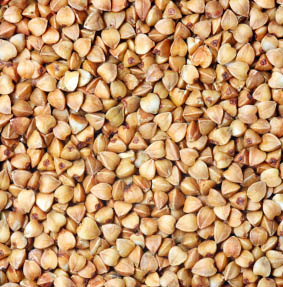Buckwheat

Despite its name, buckwheat is not related to wheat, and is technically not a grain at all. It is actually a fruit seed, but is generally categorized with grains because it serves as an excellent gluten-free substitute for other cereal grains.
Buckwheat can be prepared as a porridge or as a rice substitute. Buckwheat flour is now frequently used in breakfast cereals, cakes, and breads. Buckwheat can be sprouted in 2-3 days for use in raw food recipes or a salad topping.
To cook like rice: Combine 1 cup buckwheat with 2 cups water. Bring to a boil, then cover and lower heat to simmer for 30 minutes.
Visit Living and Raw Foods for sprouting instructions.
| Serving size: | 1/2 cup, before preparation (85 g) |
| Region: | Europe, Asia, North America |
Health Benefits
| Blood Pressure | Regular intake of buckwheat has been linked to lowered risk of high blood pressure. |
| Blood Sugar | Food made from buckwheat has been shown to lower blood glucose levels and insulin responses, especially when compared with similar foods made from refined wheat flour. New evidence also suggests that buckwheat may help manage diabetes. |
| Heart | High buckwheat intake was shown to be associated with low cholesterol in the Yi people of China, who consume buckwheat regularly. |
| Weight Loss | Buckwheat makes the body feel full faster than more common grains, causing one to eat less. Buckwheat also acts as an appetite suppressant. |
Nutrients
| Copper | 1 mg | 50% | |
| Fiber | 8.5 g | 34% | |
| Iron | 1.9 mg | 13% | |
| Magnesium | 197 mg | 49% | |
| Manganese | 1.1 mg | 37% | |
| Phosphorous | 295 mg | 25% | |
| Potassium | 391 mg | 11% | |
| Protein/Amino Acids | 11 g | 22% | Contains abundant levels of all essential amino acids and has a protein quality score of 99. |
| Selenium | 7 mcg | 10% | |
| Vitamin B2/Riboflavin | 0.35 mg | 21% | |
| Vitamin B3/Niacin | 6 mg | 30% | Contains an unusually high level of niacin compared with other plant-based foods. |
| Vitamin B5/Pantothetic Acid | 1 mg | 10% | |
| Vitamin B6 | 0.2 mg | 11% | |
| Zinc | 2 mg | 13% |
